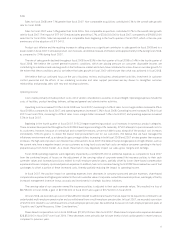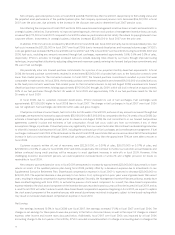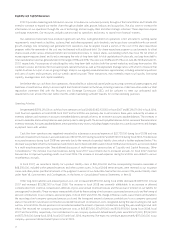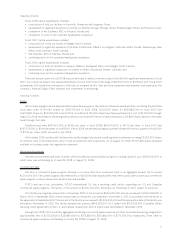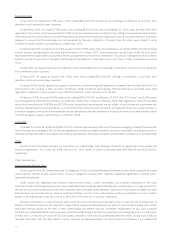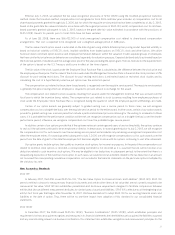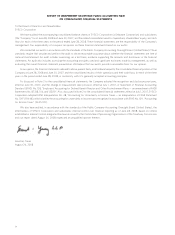Sysco 2008 Annual Report Download - page 49
Download and view the complete annual report
Please find page 49 of the 2008 Sysco annual report below. You can navigate through the pages in the report by either clicking on the pages listed below, or by using the keyword search tool below to find specific information within the annual report.the June 30, 2007 measurement date, decreased 0.09% to 6.64%. The combined effect of these discount rate changes was a decrease in
our net company-sponsored pension costs for all plans for fiscal 2008 by an estimated $480,000. The discount rate for determining fiscal
2009 net pension costs for the Retirement Plan, which was determined as of the June 28, 2008 measurement date, increased 0.16% to
6.94%. The discount rate for determining fiscal 2009 net pension costs for the SERP, which was determined as of the June 28, 2008
measurement date, increased 0.39% to 7.03%. The combined effect of these discount rate changes will decrease our net company-
sponsored pension costs for all plans for fiscal 2009 by an estimated $8,692,000. A 1.0% increase in the discount rates for fiscal 2009
would decrease SYSCO’s net company-sponsored pension cost by $32,000,000, while a 1.0% decrease in the discount rates would
increase pension cost by $49,000,000. The impact of a 1.0% increase in the discount rates differs from the impact of a 1.0% decrease in
discount rates because a 1.0% decrease in discount rates would require additional amounts of amortization from net actuarial losses which
would not be required with a 1.0% increase in this rate. As of June 28, 2008, our net actuarial losses from our company-sponsored pension
plans were $351,344,000, an increase of $192,438,000. We estimate the amortization of net actuarial losses will increase our fiscal 2009
pension expense by approximately $14,000,000 as compared to fiscal 2008.
We look to actual plan experience in determining the rates of increase in compensation levels. We used a plan specific age-related set
of rates for the Retirement Plan, which are equivalent to a single rate of 6.17% as of June 28, 2008 and June 30, 2007. As of June 28, 2008,
the SERP assumes various levels of base salary increase and decrease for determining pay for fiscal 2009 depending upon the participant’s
position with the company and a 7% salary growth assumption for all participants for fiscal 2010 and thereafter. As of June 30, 2007, the
SERP assumed salary rate increases of 10% through fiscal 2007 and 7% thereafter.
The expected long-term rate of return on plan assets of the Retirement Plan was 8.50% for fiscal 2008 and 9.00% for fiscal 2007.The
expectations of future returns are derived from a mathematical asset model that incorporates assumptions as to the various asset class
returns, reflecting a combination of historical performance analysis and the forward-looking views of the financial markets regarding the
yield on long-term bonds and the historical returns of the major stock markets. Although not determinative of future returns, the effective
annual rate of return on plan assets, developed using geometric/compound averaging, was approximately 9.0%, 7.3%, 12.1% and 8.3% over
the 20-year, 10-year, 5-year and 1-year periods ended December 31, 2007, respectively. In addition, in nine of the last 15 years, the actual
return on plan assets has exceeded 10.0%. The rate of return assumption is reviewed annually and revised as deemed appropriate.
The expected return on plan assets impacts the recorded amount of net pension costs. The expected long-term rate of return on plan
assets of the Retirement Plan is 8.00% for fiscal 2009. A 1.0% increase (decrease) in the assumed rate of return for fiscal 2009 would
decrease (increase) SYSCO’s net company-sponsored pension costs for fiscal 2009 by approximately $15,900,000.
The adoption of the recognition and disclosure provisions of SFAS 158 as of June 30, 2007 resulted in the recognition of the funded
status of our defined benefit plans in the statement of financial position, with a corresponding adjustment to accumulated other
comprehensive income, net of tax. The amount reflected in accumulated other comprehensive loss as of June 30, 2007 after adoption
of SFAS 158 was a charge, net of tax, of $125,265,000, which represented the net actuarial losses, prior service costs and transition
obligation remaining from the initial adoption of SFAS 87/106 as of that date. The amount reflected in accumulated other comprehensive
loss related to the recognition of the funded status of our defined benefit plans as of June 28, 2008 was a charge, net of tax, of $220,913,000.
Changes in the assumptions, including changes to the discount rate discussed above, together with the normal growth of the plans, the
impact of actuarial losses from prior periods and the timing and amount of contributions, decreased net company-sponsored pension costs
by $8,754,000 in fiscal 2008 and are expected to increase net company-sponsored pension costs in fiscal 2009 by approximately
$27,200,000. However, a change in the SERP design is expected to decrease net company-sponsored pension costs in fiscal 2009 by
$7,200,000, for a net increase of approximately $20,000,000.
We made cash contributions to our company-sponsored pension plans of $92,670,000 and $91,163,000 in fiscal years 2008 and
2007, respectively, including voluntary contributions to the Retirement Plan of $80,000,000 and $80,000,000 in fiscal 2008 and fiscal
2007, respectively. In fiscal 2009, as in the previous years, contributions to the Retirement Plan will not be required to meet ERISA minimum
funding requirements but we anticipate that we will make voluntary contributions of $80,000,000, which is not greater than the estimated
maximum amount that will be tax deductible in fiscal 2009. The estimated fiscal 2009 contributions to fund benefit payments for the SERP
and other post-retirement plans together are approximately $17,401,000.
Income Taxes
The determination of our provision for income taxes requires significant judgment, the use of estimates and the interpretation and
application of complex tax laws. Our provision for income taxes reflects a combination of income earned and taxed in the various U.S. federal
and state, as well as Canadian federal and provincial jurisdictions. Jurisdictional tax law changes, increases or decreases in permanent
differences between book and tax items, accruals or adjustments of accruals for unrecognized tax benefits or valuation allowances, and our
change in the mix of earnings from these taxing jurisdictions all affect the overall effective tax rate.
Prior to fiscal 2008, in evaluating the exposures connected with the various tax filing positions, we established an accrual when, despite
our belief that our tax return positions were supportable, we believed that certain positions may be successfully challenged and a loss was
probable. When facts and circumstances changed, these accruals were adjusted. Beginning in fiscal 2008, we adopted FIN 48, which
changed the accounting for uncertain tax positions. FIN 48 provides that a tax benefit from an uncertain tax position may be recognized
25


